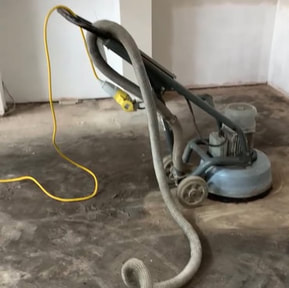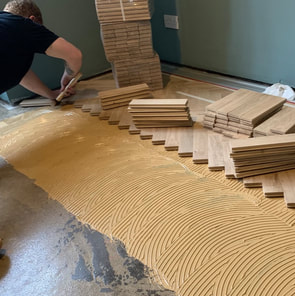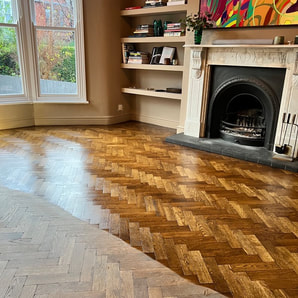Our herringbone parquet.
Carefully selected from FSC compliant, well managed forests that promote sustainability within forestry. We offer all traditional and modern block sizes, all compositions from solid to engineered that are suitable for underfloor heating systems.
Our herringbone floors are finished and protected to suit your exact needs and requirements. Carefully crafted on site, to deliver a truly beautiful masterpiece.
Sustainably sourced, carefully selected, professionally installed and finished.
Our herringbone floors are finished and protected to suit your exact needs and requirements. Carefully crafted on site, to deliver a truly beautiful masterpiece.
Sustainably sourced, carefully selected, professionally installed and finished.
Design.
|
From 230mm to 500mm long solid Oak blocks, engineered compositions for oversize herringbone block, thick blocks, thin blocks. Prime grade, rustic grade, bevel edge, tumbled, square edge. Brushed, oiled, stained, lacquered... There are so many choices available and we are here to help guide you through to the right choice, for the perfect hardwood floor.
Herringbone parquet has a lot to offer any space. It can completely change the appearance of any room, dramatically adding value in more ways than one. Our experience will help you decide on the right specification for your project, big or small. |
Prepare.
|
The success to any herringbone floor that will stand the test of time isn't in the finish. It's not in the quality of the wood used, not even the experience of the fitter. These vital elements are all lost without proper, thorough subfloor preparation.
We survey and assess your existing subfloors and prepare a preparation strategy that follows a thorough system to ensure that your hardwood floor lives up to it's reputation. Subfloor preparation is crucial to a lasting, healthy hardwood floor. |
Install.
|
Our in-house, full time team of parquetry installers and finishers will not only prepare your subfloor, but will be with you through every step of the installation. Taking great care to carefully think out the layout and orientation of your hardwood flooring. Carefully negotiating curves, islands, reveals, through-rooms and changes in levels to tackle some of the most challenging installations to deliver a faultless herringbone parquet floor.
Offering borders, bespoke inlays, curves, creative use of awkward spaces, as well as handmade transitions from our flooring to other / existing flooring, we have a solution for all. Working respectfully within your homes and businesses, our team are dedicated to installing a hardwood floor that they are proud to leave you with. |
Protect.
|
Last but not least, once all other stages are completed in full; we listen to your requirements, talk colour tones, sheen levels, tactile effects and come to a decision on the most suitable protective coating system for your hardwood floor.
With a wide selection of industry leading wood floor coatings on offer, we make your Oak herringbone floor just right for you. Offering ease of ongoing maintenance that can be incorporated into your routine cleaning. |
Make your flooring, make your home
A focal point that keeps on giving
Get a FREE estimate
All of our estimates and quotations are completely free, with no obligation.



